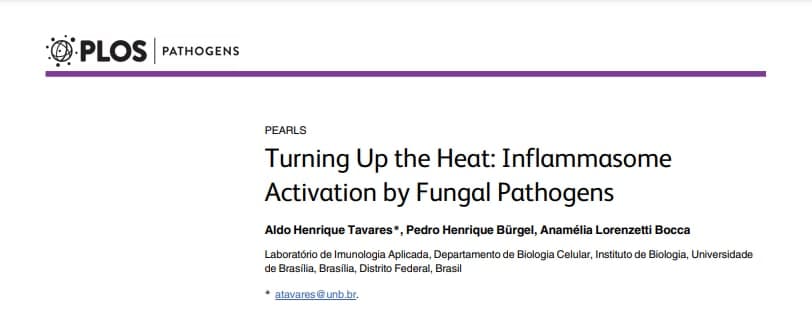Publicações Principais
Turning Up the Heat: Inflammasome Activation by Fungal Pathogens
Abstract
Since its first description in 2002 [1], the inflammasome has been implicated in the mechanisms underlying a growing number of infectious, autoimmune, and metabolic diseases [2]. Regarding infectious processes, several studies have shown the involvement of this critical component of innate immunity in the outcome of infection with nearly every class of microbe, including fungi [3]. Innate immunity is the frontline of defense against infection and relies on the ability of its main players (phagocytes and epithelial barriers) to detect conserved components of microbes or pathogen-associated molecular patterns (PAMPs). In fungi, the carbohydrate polymers of the cell wall, such as chitin, β-glucan, and mannan are the major PAMPs recognized by the host’s innate immune cells; this recognition occurs via germline-encoded receptors termed pattern recognition receptors (PRRs) [4]. In addition to PAMPs, endogenous molecules associated with damaged host cells, or damage-associated molecular patterns (DAMPs), are released during tissue injury and activate PRRs. This innate detection system includes the Toll-like receptors (TLRs), C-type lectin receptors (CLRs), RIG-I-like receptors (RLRs), NOD-like receptors (NLRs), and AIM2-like receptors (ALRs). Although the main fungal-recognition PRRs (CLRs and TLRs) are bound to the cytoplasmic membrane of innate immune cells [4], fungal sensing by PRRs located in the cytosol, such as the NLRs and ALRs, is becoming increasingly evident. A number of NLRs and ALRs can assemble into the inflammasome, a multiprotein complex consisted of PRRs such as NLRP3 (NLR family, pyrin domain-containing 3), NLRC4, or AIM2, adaptor protein ASC (apoptosis-associated speck-like protein containing a caspase activation and recruitment domain (CARD), and procaspase-1 [3]. Upon formation of the complex, procaspase-1 is cleaved into an active cysteine protease, which further cleaves the proinflammatory cytokines IL-1β and IL-18 into their mature forms, followed by unconventional secretion. IL-1β and IL-18 mediate several innate antimicrobial responses and are critical to direct adaptive Th17/Th1 cellular responses [5]. In addition, inflammasome activation causes pyroptosis, a lytic inflammatory form of cell death [2,5].


